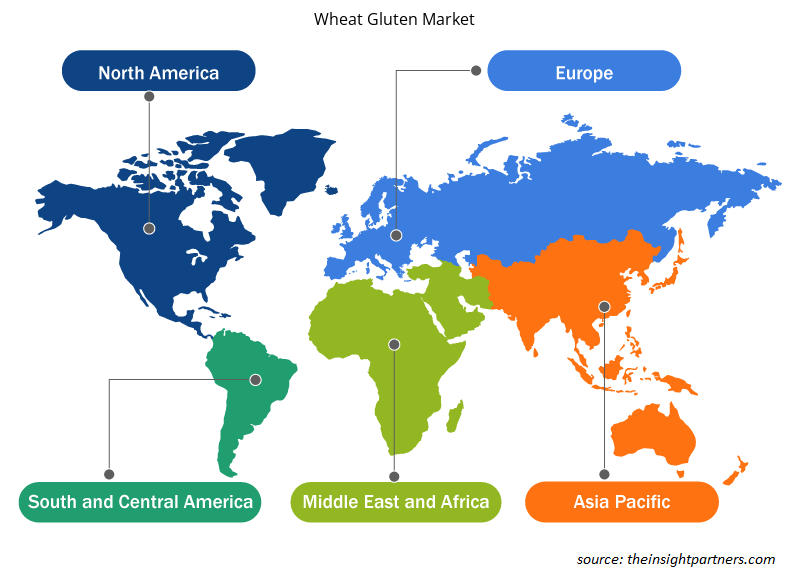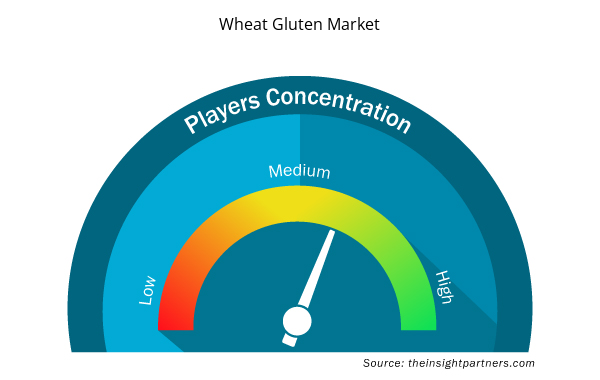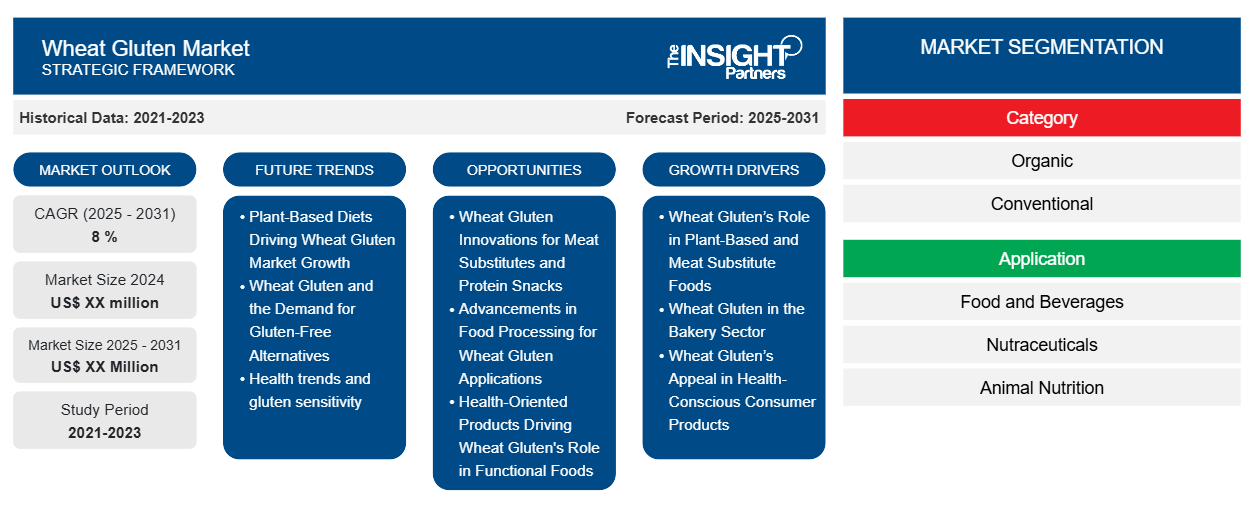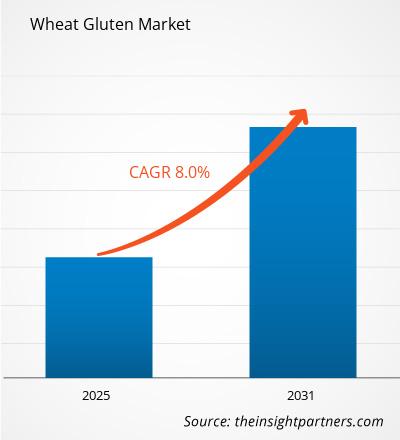Le marché du gluten de blé devrait enregistrer un TCAC de 8 % de 2023 à 2031, avec une taille de marché passant de XX millions USD en 2023 à XX millions USD d'ici 2031.
Le rapport est segmenté par catégorie (biologique, conventionnel). Le rapport présente en outre une analyse basée sur l'application (aliments et boissons, nutraceutiques, nutrition animale, autres). L'analyse mondiale est ensuite décomposée au niveau régional et par principaux pays. En termes de géographie, le marché est divisé en Amérique du Nord, Europe, Asie-Pacifique, Moyen-Orient et Afrique, et Amérique du Sud et centrale). Le rapport offre la valeur en USD pour l'analyse et les segments ci-dessus.
Objectif du rapport
Le rapport sur le marché du gluten de blé de The Insight Partners vise à décrire le paysage actuel et la croissance future, les principaux facteurs moteurs, les défis et les opportunités. Cela fournira des informations à diverses parties prenantes commerciales, telles que :
- Fournisseurs/fabricants de technologie : pour comprendre l’évolution de la dynamique du marché et connaître les opportunités de croissance potentielles, leur permettant de prendre des décisions stratégiques éclairées.
- Investisseurs : Effectuer une analyse complète des tendances concernant le taux de croissance du marché, les projections financières du marché et les opportunités qui existent tout au long de la chaîne de valeur.
- Organismes de réglementation : Réglementer les politiques et surveiller les activités du marché dans le but de minimiser les abus, de préserver la confiance des investisseurs et de maintenir l’intégrité et la stabilité du marché.
Segmentation du marché du gluten de blé
Catégorie
- Organique
- Conventionnel
Application
- Alimentation et boissons
- Nutraceutiques
- Nutrition animale
- Autres
Personnalisez ce rapport en fonction de vos besoins
Vous bénéficierez d'une personnalisation gratuite de n'importe quel rapport, y compris de certaines parties de ce rapport, d'une analyse au niveau des pays, d'un pack de données Excel, ainsi que d'offres et de remises exceptionnelles pour les start-ups et les universités.
- Obtenez les principales tendances clés du marché de ce rapport.Cet échantillon GRATUIT comprendra une analyse de données, allant des tendances du marché aux estimations et prévisions.
Facteurs de croissance du marché du gluten de blé
- Rôle du gluten de blé dans les aliments à base de plantes et les substituts de viande : La tendance croissante vers les aliments de gros à base de plantes augmente les besoins en gluten de blé, qui est riche en protéines et polyvalent dans son utilisation. Étant donné que les consommateurs recherchent des substituts de viande, le gluten de blé est désormais utilisé de nombreuses façons, notamment sous forme de substituts de viande et de collations riches en protéines, ce qui contribue à la croissance du marché.
- Le gluten de blé dans le secteur de la boulangerie : La croissance du marché du gluten de blé est favorisée par le secteur de la boulangerie qui utilise le gluten pour améliorer la consistance et l'extensibilité de la pâte. Avec l'augmentation de la consommation par habitant de pain et d'autres produits de boulangerie dans le monde, la demande en gluten de blé devrait augmenter, favorisant ainsi la croissance de son marché.stretchability of dough. With the increase in the per capita consumption of bread and other baked products around the world, the requirement for wheat gluten is projected to grow, thereby aiding its market growth.
- L'attrait du gluten de blé dans les produits de consommation soucieux de leur santé : On constate une augmentation notable de la conscience de la population en matière de santé ; par conséquent, il existe une propension à rechercher des ressources alimentaires de nature fonctionnelle. Le gluten de blé étant une source riche en protéines et en fibres, on assiste à une évolution vers le développement de produits plus soucieux de leur santé, ce qui entraîne de nouveaux changements positifs sur le marché.
Tendances futures du marché du gluten de blé
- Les régimes à base de plantes stimulent la croissance du marché du gluten de blé : La tendance des régimes à base de plantes à la hausse du marché du gluten de blé destiné à être utilisé dans les substituts de viande et les aliments enrichis en protéines est en pleine croissance. Cependant, une telle évolution est une réponse à l'évolution de l'attitude des consommateurs à l'égard des aliments sains et respectueux de l'environnement, élargissant encore la portée du marché et stimulant sa croissance.
- Gluten de blé et demande d'alternatives sans gluten : Les gens sont de plus en plus conscients des problèmes de santé liés au gluten, qu'il s'agisse de la maladie cœliaque ou de l'intolérance au gluten, ce qui facilite la définition du marché cible des produits sans gluten. Cette tendance affecte l'innovation et le comportement des consommateurs des producteurs, les amenant à réfléchir à des moyens de produire des produits sans gluten et en même temps à produire des produits à base de gluten de blé.
- Tendances en matière de santé et sensibilité au gluten : les régimes sans gluten gagnent en popularité auprès des personnes allergiques ou sensibles au gluten. Par conséquent, les fabricants se concentrent sur le développement de produits à teneur réduite en gluten pour les consommateurs à la recherche de produits à faible teneur en gluten.
Opportunités de marché pour le gluten de blé
- Innovations à base de gluten de blé pour les substituts de viande et les collations protéinées : Alors que de plus en plus de personnes adoptent le végétarisme, la demande d'innovations alimentaires à base de gluten de blé se fait sentir, notamment dans le développement de substituts de viande et de collations riches en protéines. En effet, il est facile à fabriquer sous des formes texturées et contient un pourcentage élevé de protéines, un aspect qui est attrayant pour les fabricants de produits alimentaires ciblant ce groupe de consommateurs.
- Progrès dans la transformation des aliments pour les applications du gluten de blé : De plus, les progrès réalisés dans la transformation de l'industrie alimentaire et les technologies de pointe permettent d'inventer d'autres attributs du gluten de blé. Il peut s'agir d'améliorations des compositions réelles des gâteaux, des nouilles, etc., qui permettront aux producteurs de s'adapter à l'évolution des demandes du marché pour des produits alimentaires propres, plus sains et fonctionnels.
- Les produits axés sur la santé stimulent le rôle du gluten de blé dans les aliments fonctionnels : En ce qui concerne la question de la demande en produits alimentaires axés sur la santé, le marché des aliments fonctionnels se développe principalement en raison du changement de comportement des consommateurs. Cela s'explique également par le fait que le gluten de blé est une bonne source de protéines et de fibres et que davantage de produits axés sur la santé pourraient être développés en l'incluant comme matière première essentielle, conformément aux nouvelles tendances en matière de santé.
Aperçu régional du marché du gluten de blé
Les tendances et facteurs régionaux influençant le marché du gluten de blé tout au long de la période de prévision ont été expliqués en détail par les analystes d’Insight Partners. Cette section traite également des segments et de la géographie du marché du gluten de blé en Amérique du Nord, en Europe, en Asie-Pacifique, au Moyen-Orient et en Afrique, ainsi qu’en Amérique du Sud et en Amérique centrale.

- Obtenez les données régionales spécifiques au marché du gluten de blé
Portée du rapport sur le marché du gluten de blé
| Attribut de rapport | Détails |
|---|---|
| Taille du marché en 2023 | XX millions de dollars américains |
| Taille du marché d'ici 2031 | XX millions de dollars américains |
| Taux de croissance annuel composé mondial (2023-2031) | 8 % |
| Données historiques | 2021-2022 |
| Période de prévision | 2024-2031 |
| Segments couverts | Par catégorie
|
| Régions et pays couverts | Amérique du Nord
|
| Leaders du marché et profils d'entreprises clés |
|
Densité des acteurs du marché du gluten de blé : comprendre son impact sur la dynamique commerciale
Le marché du gluten de blé connaît une croissance rapide, tirée par la demande croissante des utilisateurs finaux en raison de facteurs tels que l'évolution des préférences des consommateurs, les avancées technologiques et une plus grande sensibilisation aux avantages du produit. À mesure que la demande augmente, les entreprises élargissent leurs offres, innovent pour répondre aux besoins des consommateurs et capitalisent sur les tendances émergentes, ce qui alimente davantage la croissance du marché.
La densité des acteurs du marché fait référence à la répartition des entreprises ou des sociétés opérant sur un marché ou un secteur particulier. Elle indique le nombre de concurrents (acteurs du marché) présents sur un marché donné par rapport à sa taille ou à sa valeur marchande totale.
Les principales entreprises opérant sur le marché du gluten de blé sont :
- Bryan W Nash et Fils Ltée
- Cargill, société incorporée
- Kroener Staerke
- Loryma GmbH
- Ingrédients MGP
Avis de non-responsabilité : les sociétés répertoriées ci-dessus ne sont pas classées dans un ordre particulier.

- Obtenez un aperçu des principaux acteurs du marché du gluten de blé
Principaux arguments de vente
- Couverture complète : Le rapport couvre de manière exhaustive l’analyse des produits, des services, des types et des utilisateurs finaux du marché du gluten de blé, offrant un paysage holistique.
- Analyse d’experts : Le rapport est compilé sur la base d’une compréhension approfondie des experts et analystes du secteur.
- Informations à jour : Le rapport garantit la pertinence commerciale en raison de sa couverture des informations récentes et des tendances des données.
- Options de personnalisation : ce rapport peut être personnalisé pour répondre aux exigences spécifiques du client et s'adapter parfaitement aux stratégies commerciales.
Le rapport de recherche sur le marché du gluten de blé peut donc aider à ouvrir la voie au décodage et à la compréhension du scénario de l’industrie et des perspectives de croissance. Bien qu’il puisse y avoir quelques préoccupations valables, les avantages globaux de ce rapport ont tendance à l’emporter sur les inconvénients.
- Analyse historique (2 ans), année de base, prévision (7 ans) avec TCAC
- Analyse PEST et SWO
- Taille du marché Valeur / Volume - Mondial, Régional, Pays
- Industrie et paysage concurrentiel
- Ensemble de données Excel



Report Coverage
Revenue forecast, Company Analysis, Industry landscape, Growth factors, and Trends

Segment Covered
This text is related
to segments covered.

Regional Scope
North America, Europe, Asia Pacific, Middle East & Africa, South & Central America

Country Scope
This text is related
to country scope.
Questions fréquemment posées
The report can be delivered in PDF/Word format, we can also share excel data sheet based on request.
Cargill Incorporated, Roquette Frères S.A, Royal Ingredients Group, Pioneer Industries Limited, Permolex Ltd, Z and F Sungold Corporation, Kroener Staerke, Agrana, Sacchetto S.p.A. and Co KG are the key players operating in the market
Based on geography, North America held the largest share of the wheat gluten market.
Significantly growing bakery industry, and rising demand for functional food are the major factors driving the wheat gluten market growth.
Increasing consumer awareness about gluten sensitivity is likely to remain the key trends in the market.
The Wheat Gluten Market is estimated to witness a CAGR of 8 % from 2023 to 2031
Trends and growth analysis reports related to Food and Beverages : READ MORE..
1. Bryan W Nash and Sons Ltd
2. Cargill, Incorporated
3. Kroener Staerke
4. Loryma GmbH
5. MGP Ingredients
6. Nugen Feeds and Foods
7. Pioneer Industries Limited
8. Royal Ingredients Group
9. Sacchetto S.p.A.
10. Tereos S.A.
The Insight Partners performs research in 4 major stages: Data Collection & Secondary Research, Primary Research, Data Analysis and Data Triangulation & Final Review.
- Data Collection and Secondary Research:
As a market research and consulting firm operating from a decade, we have published and advised several client across the globe. First step for any study will start with an assessment of currently available data and insights from existing reports. Further, historical and current market information is collected from Investor Presentations, Annual Reports, SEC Filings, etc., and other information related to company’s performance and market positioning are gathered from Paid Databases (Factiva, Hoovers, and Reuters) and various other publications available in public domain.
Several associations trade associates, technical forums, institutes, societies and organization are accessed to gain technical as well as market related insights through their publications such as research papers, blogs and press releases related to the studies are referred to get cues about the market. Further, white papers, journals, magazines, and other news articles published in last 3 years are scrutinized and analyzed to understand the current market trends.
- Primary Research:
The primarily interview analysis comprise of data obtained from industry participants interview and answers to survey questions gathered by in-house primary team.
For primary research, interviews are conducted with industry experts/CEOs/Marketing Managers/VPs/Subject Matter Experts from both demand and supply side to get a 360-degree view of the market. The primary team conducts several interviews based on the complexity of the markets to understand the various market trends and dynamics which makes research more credible and precise.
A typical research interview fulfils the following functions:
- Provides first-hand information on the market size, market trends, growth trends, competitive landscape, and outlook
- Validates and strengthens in-house secondary research findings
- Develops the analysis team’s expertise and market understanding
Primary research involves email interactions and telephone interviews for each market, category, segment, and sub-segment across geographies. The participants who typically take part in such a process include, but are not limited to:
- Industry participants: VPs, business development managers, market intelligence managers and national sales managers
- Outside experts: Valuation experts, research analysts and key opinion leaders specializing in the electronics and semiconductor industry.
Below is the breakup of our primary respondents by company, designation, and region:

Once we receive the confirmation from primary research sources or primary respondents, we finalize the base year market estimation and forecast the data as per the macroeconomic and microeconomic factors assessed during data collection.
- Data Analysis:
Once data is validated through both secondary as well as primary respondents, we finalize the market estimations by hypothesis formulation and factor analysis at regional and country level.
- Macro-Economic Factor Analysis:
We analyse macroeconomic indicators such the gross domestic product (GDP), increase in the demand for goods and services across industries, technological advancement, regional economic growth, governmental policies, the influence of COVID-19, PEST analysis, and other aspects. This analysis aids in setting benchmarks for various nations/regions and approximating market splits. Additionally, the general trend of the aforementioned components aid in determining the market's development possibilities.
- Country Level Data:
Various factors that are especially aligned to the country are taken into account to determine the market size for a certain area and country, including the presence of vendors, such as headquarters and offices, the country's GDP, demand patterns, and industry growth. To comprehend the market dynamics for the nation, a number of growth variables, inhibitors, application areas, and current market trends are researched. The aforementioned elements aid in determining the country's overall market's growth potential.
- Company Profile:
The “Table of Contents” is formulated by listing and analyzing more than 25 - 30 companies operating in the market ecosystem across geographies. However, we profile only 10 companies as a standard practice in our syndicate reports. These 10 companies comprise leading, emerging, and regional players. Nonetheless, our analysis is not restricted to the 10 listed companies, we also analyze other companies present in the market to develop a holistic view and understand the prevailing trends. The “Company Profiles” section in the report covers key facts, business description, products & services, financial information, SWOT analysis, and key developments. The financial information presented is extracted from the annual reports and official documents of the publicly listed companies. Upon collecting the information for the sections of respective companies, we verify them via various primary sources and then compile the data in respective company profiles. The company level information helps us in deriving the base number as well as in forecasting the market size.
- Developing Base Number:
Aggregation of sales statistics (2020-2022) and macro-economic factor, and other secondary and primary research insights are utilized to arrive at base number and related market shares for 2022. The data gaps are identified in this step and relevant market data is analyzed, collected from paid primary interviews or databases. On finalizing the base year market size, forecasts are developed on the basis of macro-economic, industry and market growth factors and company level analysis.
- Data Triangulation and Final Review:
The market findings and base year market size calculations are validated from supply as well as demand side. Demand side validations are based on macro-economic factor analysis and benchmarks for respective regions and countries. In case of supply side validations, revenues of major companies are estimated (in case not available) based on industry benchmark, approximate number of employees, product portfolio, and primary interviews revenues are gathered. Further revenue from target product/service segment is assessed to avoid overshooting of market statistics. In case of heavy deviations between supply and demand side values, all thes steps are repeated to achieve synchronization.
We follow an iterative model, wherein we share our research findings with Subject Matter Experts (SME’s) and Key Opinion Leaders (KOLs) until consensus view of the market is not formulated – this model negates any drastic deviation in the opinions of experts. Only validated and universally acceptable research findings are quoted in our reports.
We have important check points that we use to validate our research findings – which we call – data triangulation, where we validate the information, we generate from secondary sources with primary interviews and then we re-validate with our internal data bases and Subject matter experts. This comprehensive model enables us to deliver high quality, reliable data in shortest possible time.


 Obtenez un échantillon gratuit pour ce rapport
Obtenez un échantillon gratuit pour ce rapport